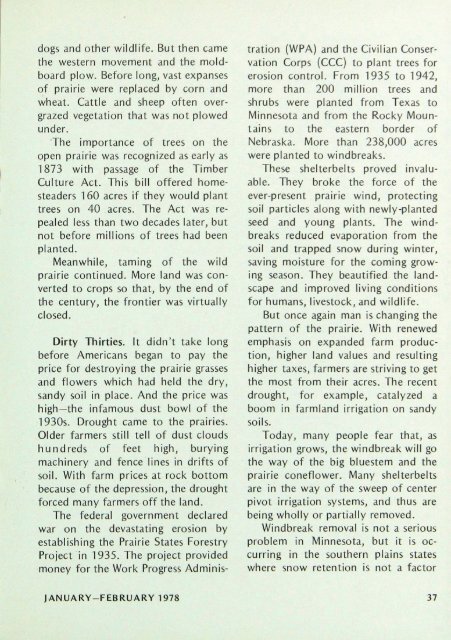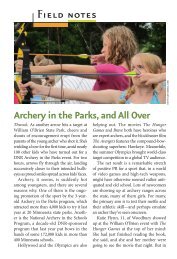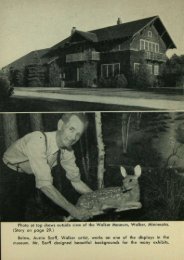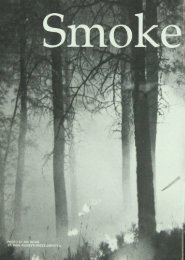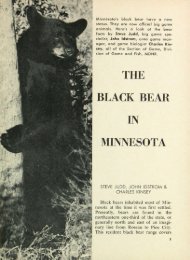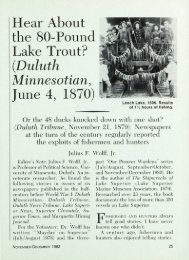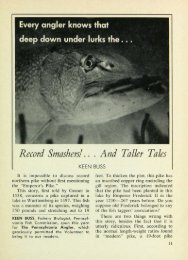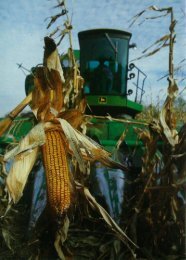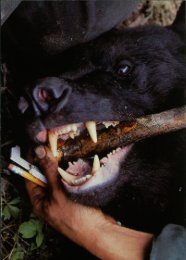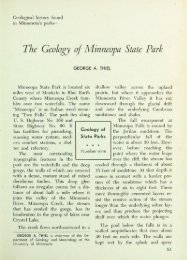1945 Windbreaks: Natural Erosion Control - webapps8
1945 Windbreaks: Natural Erosion Control - webapps8
1945 Windbreaks: Natural Erosion Control - webapps8
You also want an ePaper? Increase the reach of your titles
YUMPU automatically turns print PDFs into web optimized ePapers that Google loves.
dogs and other wildlife. But then came<br />
the western movement and the moldboard<br />
plow. Before long, vast expanses<br />
of prairie were replaced by corn and<br />
wheat. Cattle and sheep often overgrazed<br />
vegetation that was not plowed<br />
under.<br />
The importance of trees on the<br />
open prairie was recognized as early as<br />
1873 with passage of the Timber<br />
Culture Act. This bill offered homesteaders<br />
160 acres if they would plant<br />
trees on 40 acres. The Act was repealed<br />
less than two decades later, but<br />
not before millions of trees had been<br />
planted.<br />
Meanwhile, taming of the wild<br />
prairie continued. More land was converted<br />
to crops so that, by the end of<br />
the century, the frontier was virtually<br />
closed.<br />
Dirty Thirties. It didn't take long<br />
before Americans began to pay the<br />
price for destroying the prairie grasses<br />
and flowers which had held the dry,<br />
sandy soil in place. And the price was<br />
high—the infamous dust bowl of the<br />
1930s. Drought came to the prairies.<br />
Older farmers still tell of dust clouds<br />
hundreds of feet high, burying<br />
machinery and fence lines in drifts of<br />
soil. With farm prices at rock bottom<br />
because of the depression, the drought<br />
forced many farmers off the land.<br />
The federal government declared<br />
war on the devastating erosion by<br />
establishing the Prairie States Forestry<br />
Project in 1935. The project provided<br />
money for the Work Progress Administration<br />
(WPA) and the Civilian Conservation<br />
Corps (CCC) to plant trees for<br />
erosion control. From 1935 to 1942,<br />
more than 200 million trees and<br />
shrubs were planted from Texas to<br />
Minnesota and from the Rocky Mountains<br />
to the eastern border of<br />
Nebraska. More than 238,000 acres<br />
were planted to windbreaks.<br />
These shelterbelts proved invaluable.<br />
They broke the force of the<br />
ever-present prairie wind, protecting<br />
soil particles along with newly-planted<br />
seed and young plants. The windbreaks<br />
reduced evaporation from the<br />
soil and trapped snow during winter,<br />
saving moisture for the coming growing<br />
season. They beautified the landscape<br />
and improved living conditions<br />
for humans, livestock, and wildlife.<br />
But once again man is changing the<br />
pattern of the prairie. With renewed<br />
emphasis on expanded farm production,<br />
higher land values and resulting<br />
higher taxes, farmers are striving to get<br />
the most from their acres. The recent<br />
drought, for example, catalyzed a<br />
boom in farmland irrigation on sandy<br />
soils.<br />
Today, many people fear that, as<br />
irrigation grows, the windbreak will go<br />
the way of the big bluestem and the<br />
prairie conefiower. Many shelterbelts<br />
are in the way of the sweep of center<br />
pivot irrigation systems, and thus are<br />
being wholly or partially removed.<br />
Windbreak removal is not a serious<br />
problem in Minnesota, but it is occurring<br />
in the southern plains states<br />
where snow retention is not a factor<br />
)ANUA RY —FEBRUARY 1978 37


